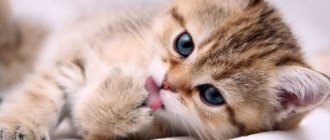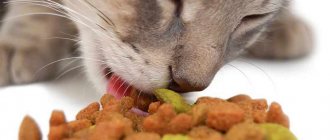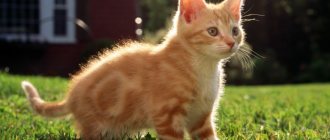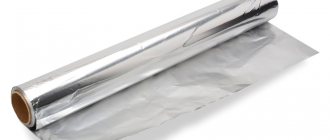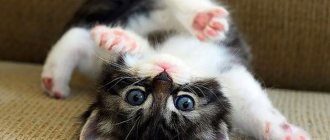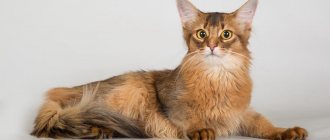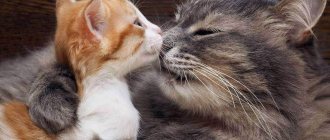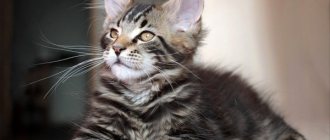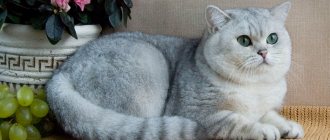What kind of exhibitions are there?
Each association has its own rules and nuances for holding exhibitions, which cat breeders should familiarize themselves with in advance. Events are divided by type of judging. Each system also has its own conditions for obtaining a title and form of membership. Main types of exhibitions:
- American;
- British;
- European.
Each cat show is held according to a specific system.
In rare cases, you can find a mixed system. In order to understand what type of event is suitable in this case, it is necessary to delve into the details of each type of exhibition. The purpose of the system is to determine whether the pet meets the breed standard. This is important for a breeder if he plans to breed a certain type of cat. At the same time, experts evaluate the pet according to a number of parameters that it must meet.
For an animal, an exhibition is a lot of stress, so it is important to carefully prepare the cat for the upcoming event, especially if the animal never leaves the house and is afraid of strangers.
European system
The European version involves individual judging, in which everything is recorded in writing. For these purposes, the appraiser is provided with a special form with characteristics, which must be filled out after examining the pet. The cat is brought to the judge by a trained person, not the owner himself. This rule allows you to maintain anonymity. This system can protect the animal from a number of infections, since after each pet the table is wiped with disinfectants, and the appraiser treats his hands with an antiseptic.
At the end of the event, the cat's owner takes the ratings and description of the breed, which remain in his hands. Registration is carried out only by club members who are logged into the system. Title registration is also carried out only for those who have joined the community. During the evaluation of the cat, only an assistant is allowed next to the judge. Third parties excluded. To receive a certain title, a cat must be evaluated by three judges. The participant must be at least three months old to qualify for the award.
At the end of the exhibition, the cat can receive an honorary title
In order to receive a high title, you need to participate in events that are held in different countries. List of European subsystems:
- WCF - the cat must receive an assessment, as well as honorary titles at the end of the event, if available, the corresponding certificate can be issued;
- FIFe - includes the “best in color” competition, following which the animal can take part in “Best in show” - an honorary competition for those who have succeeded in other categories;
- FARUS - the subsystem is similar in rules to WCF, but has some characteristics of the American system - ring competition;
- MFA - only animals of the same breed, color, sex and show class can compete;
- WACC - the breed is assessed according to certain categories, the cat can receive the title “World Champion” or “European Champions”;
- OFA - this subsystem is similar to all of those listed, it implies strict veterinary control, the assessment can be made by one judge or several at once.
The European system is the most common of all and requires a mandatory fee for participation.
American
This system provides for passing the examination in one day, which greatly simplifies the task compared to the European type of event. Animals that are at least four months old are allowed to participate. Registration can take place directly, without involving the club. A special feature of this system is the assessment of a group of cats at once. In addition to the judges, anyone can attend.
Exhibitions according to the American system are like a performance, the participants of which can be followed by everyone
The group of pets for evaluation must consist of representatives of the same breed and color. The description of the animal, unlike the European system, is oral. In addition, all titles can be closed in one region, which is also very convenient for the breeder. Subtypes of the American system:
- CFA - there is a special coding system for the animal’s breed, and the gender and genetics of the pet are also taken into account;
- TICA - documents for participation can be submitted by e-mail, there is no title division (classified depending on age);
- ICU - there is a separate class for neutered pets, the color of the ribbon (award) means what place the pet took in the competition;
- WCA - almost identical to the CFA system, it is preferable for those breeders who intend to sell pets abroad;
- RUI is an almost identical system to the ones listed above. Several judges evaluate the animals at once, and everyone who wishes follows the progress of the competition. However, if the pet is aggressive, it will be disqualified;
- The CFF is one of the oldest American systems, the rules of which are quite strict, but this reduces the risk of unfair judging. Each expert selects the 10 best pets in his ring.
The American system is more spectacular, reminiscent of a show, which is why many breeders prefer it. However, for fearful and irritable pets, such a competition will be a real test.
British
To participate in an event using the British system, you must be a member of one of the clubs. The same algorithm is used to design the animal. During the exhibition, all pets are placed in separate cages, and the breeders leave the hall. The appraiser, together with an assistant, makes a description of the breeds, taking into account even the slightest discrepancies. The breeder receives the conclusion in writing on the second day after the event.
The British show system involves placing cats in separate cages
Judges do not evaluate groups of pets, but individual breeds. After the examination, the hall is opened to everyone. The award ceremony takes place on stage.
The British system is used very rarely and is less in demand compared to the European and American ones.
conclusions
Today we talked about cat shows, and why they are held, what useful things you can learn from this event, how to prepare for it and how to prepare your cat for this important day. We also considered the basic rules of behavior during the exhibition. We hope that following our tips and tricks will help your cat get the reward it deserves.
Does your cat participate in exhibitions? What titles does she have? We are waiting for your comments and invite you to join the discussion of this topic in our VKontakte group...
We are waiting for your feedback and comments, join our VKontakte group!
Classes, titles and awards - table
| Class | Titles | Awards |
| Champions | "International Champion" |
|
| World Champions | "Breed Winner" | |
| Grand European Champions | "World champion" | |
| European Champions | "Grand Champion of Europe" | |
| Grand International Champions | "European Champion" | |
| International Champions | "International Grand Champion" | |
| World Premiers | "Breed winner among castrati" | "Best Neuter in Show" |
| European Premiers | "Grand Champion of Europe" | |
| Great European Premiers | "Best in show among castrati" | |
| Grand International Premiers | "Premier of Europe" | |
| International Premiers | "International Grand Premier" | |
| Premiers | "International Premier" | |
| Castrati class | "Premier" | |
| Open class | "Champion" | "Best of Breed" |
| Class of kittens aged 6 to 10 months | "Breed winner among young 6–10 months" | "Best Junior 6–10 months on show" |
| Class of kittens aged 3 to 6 months | “Breed winner among kittens 3–6 months old” | "Best kitten 3-6 months in the show" |
| Littper class | "Best litter" | "Best Litter in Show" |
| Beginners | — | — |
| Determination of color | — | — |
| Domestic cats | "Best domestic cat (cat)" |
|
the washing up
Preparing for a cat show begins with bathing, but first you need to:
- comb with a sparse comb to rid the cover of dead hairs;
- trim claws;
- clean the inside of the ears;
- if the standard allows, pluck the hair on the ears from above;
- Place cotton balls in your ears.
When bathing, the cat should have support under its feet.
Washing takes place in 5 stages:
- Using products for deep cleaning of fur, thoroughly soap the animal. Particular attention is paid to the locations of the glands - behind the ears, under the tail, paws, pants. Light wool is bleached with special means, keeping them on the cover for 3-5 minutes. Rinse thoroughly, adding vinegar (4 tbsp per 10 liters) or citric acid (1 tsp per 1 liter).
- Another soaping with a degreasing shampoo is combined with combing. A wide-toothed metal comb will come in handy. Lather your hair with a sponge or toothbrush. Rinse the animal with plenty of water.
- Lathering with exhibition shampoo, special attention to the face and paws. Rinse.
- Lathering with tinted shampoo, which will add brightness and shine to the coat. Leave for 10-15 minutes and wash off.
- For volume, the wool is treated with conditioner and styling gel. Then you need to rinse the cat thoroughly
Conditions of participation in the exhibition
To participate in the exhibition, you need to fulfill certain conditions, as well as prepare the necessary documents. The animal’s health status and age must be taken into account. In addition, you need to be prepared for the fact that you will have to contribute a certain amount to participate in the competition. The cost depends on the competition system and additional nuances that should be clarified with the organizer.
Pet age
In order to take part in the exhibition, the kitten must be over 3-4 months old (depending on the system). If the pet is younger than the stated age, then it can be counted as part of the litter and must be with its mother. There is no set upper limit. If desired, older cats can also participate in the competition, but such pets have less chance of winning.
Kittens under 3–4 months are not allowed to participate in the competition.
If you plan to breed the breed in the future, it is recommended to take an animal older than 10 months to the exhibition.
Health status
Before the competition, your pet must be vaccinated against rabies, rhinotracheitis, panleukopenia and calicivirosis. This should be done no later than 4 weeks and no earlier than 12 months before the start. Deworming is a prerequisite. For this purpose, the animal must be given anti-worm medication a month before the event.
Before the start of the competition, cats and female cats must be vaccinated
Cats with intact skin and coat are allowed to participate. If the pet is injured, then you should refrain from such an event. The same applies to animals with congenital defects: strabismus, blindness, cleft lip, etc. Pregnant and lactating pets can participate in the event, but some conditions are also provided for them.
A pregnant cat can participate in the competition, but only at the initial stage
Firstly, the cat must have no obvious signs of lactation (large and swollen nipples). Theoretically, the pet will be admitted to the competition, but will lose points if this condition is neglected. Participation in competitions is possible only in the early stages of pregnancy, when the animal’s belly is invisible. Spayed and neutered pets are allowed only to certain exhibition classes provided for in this case.
Another important point to pay attention to is the behavior of your furry friend. If the cat does not have a calm disposition, then it is not recommended to take part in the exhibition, since the pet can be disqualified for hissing, biting and fighting with competition participants.
An aggressive pet may be disqualified
Attention! Cats with injuries, lameness or other external defects cannot participate in the exhibition.
Documents that will be required
Documents that need to be prepared:
- Vet passport. Such a document is an admission to the exhibition and must contain information about all vaccinations of the animal.
- Help No. 1. This document contains information about the sanitary conditions of the area of residence. Such a certificate will be required to participate in a competition held in another region, city or country.
- Help No. 4. This paper is issued by a doctor on the basis of a veterinary passport and after examining the pet. This is a kind of conclusion about the health of the animal.
- Application for participation. It must be submitted in advance, at least a month in advance. You need to find out about registration deadlines directly by phone or on the organizer’s official website.
To participate in the exhibition you will need a veterinary passport
Additionally, it is recommended to prepare a kitten purchase and sale agreement, birth certificate and pedigree. Organizers may request such documents. Additional information that may be required must be clarified in advance to avoid getting into an awkward situation.
Upon arrival at the place
The first step is to inform the secretariat that you have arrived. To do this you need to register. Take all the documents and get in line. The secretary will check the data and give you the exhibition catalog and two plates with the number. The catalog contains information about the participants and the cat show program. Check all the data: if an error is found, notify the secretary as soon as possible and fill out a special form, otherwise the resulting score will be invalid.
If it is a large international cat show, the boxes provided by the organizers may already be numbered, then all you have to do is find your place. If not, you can choose any table you like. It is advisable that this be a place close to the expert’s table, not in a draft, not under air conditioning. You can remove the cage and set up your own tent. Now it's time to go through veterinary control.
Take with you all the documents, the cat in a carrier and a disposable diaper, which you need to lay on the table before placing the cat on it. The veterinarian will examine your pet and, if everything is in order, will issue you a veterinary certificate. The doctor will not allow an animal to be examined that appears to be unhealthy, an aggressive, deaf or overly timid cat, or a pregnant or lactating pet. In addition, cats with the phalanges of their toes (claws) removed are not allowed for examination.
Now you can settle in. Place the cat in the tent, attach one of the plates with a number to the box (the second is attached to the owner’s chest), pour the cat a drink, and decorate the box. Do not go far from the tent: when the examination begins, the steward will call you personally or your number will be announced over the speakerphone.
Preparing for the event
To get everything done, you need to start preparing several months in advance. The necessary equipment will be required that will be important for participation in the exhibition, and the animal should also be brought into proper appearance. Proper nutrition before the event plays an important role, so you need to take care of your pet’s diet in advance.
What tools and equipment will be needed?
What you need to prepare in advance:
- a metal cage with curtains - it is important to pay attention to the design, as this is an additional point in the competition;
- bedding - it is best to give preference to dense and natural material;
- tray - the deeper the cat litter, the more convenient it will be at the event;
- toilet filler - give preference to the desired one that neutralizes odors and absorbs urine well;
- two bowls - it is recommended to buy small metal or ceramic options;
- food and water;
- toys - no more than 2-3 are enough;
- antiseptic wipes - will be needed to disinfect hands and tables;
- disinfector - you need to purchase the smallest volume and an additional rag;
- comb.
Before the event, it is important to purchase a metal cat cage
Additionally, it is recommended to take care of special bags where feces are disposed of, because the cat may go to the toilet more than once during the event.
Appearance of the animal
The first thing you need to do a week before the exhibition is to bathe your pet. In this case, it is advisable to use a balm during the procedure, which will improve the appearance of the coat. It is best to comb your pet immediately before the event. If you do this in advance, the wool may mat again. During combing, it is important to remove all tangles, since their presence is unacceptable.
It is recommended to brush your pet thoroughly before the event.
Ear cleaning should also be done the night before the event if necessary. To do this, you need to carefully examine your pet's hearing aid. It is best to bend the auricle and, if there is visible dirt, moisten a cotton pad in saline solution and carefully remove the wax. You can also use a cotton swab, but under no circumstances should you push it deep into the ear canal.
Requirements for the appearance of a pet for admission to the exhibition:
- absence of fleas and dirt on the coat;
- clean eyes, nose, ears and area under the tail;
- cut transparent tips of nails;
- absence of acne and other inflammatory processes on the skin.
In order to increase the chances of getting the highest score, you can also brush your pet’s teeth immediately before the event, especially if they have yellow plaque on them.
Nutrition rules
The day before the exhibition, you can feed your pet as usual. There are no dietary restrictions. However, you should not feed your cat just a few hours before leaving for the event. This can be done immediately after the exhibition ends. If the event lasts a long time, then you can give a little food during it.
It is not recommended to overfeed a cat on the eve of an event.
The day before, it is advisable not to give the animal anything that can cause diarrhea, so it is better to exclude dairy products from the diet for a while. As for water, the animal should drink as much as it wants. In this case, there should be no prohibitions, since the pet may be thirsty due to severe stress.
Attention! If you suspect a cat has a digestive disorder, it is important to show it to a veterinarian in a timely manner, who will prescribe medication and prevent incidents from occurring during the exhibition.
How to prepare your pet for an event - video
Bringing beauty
Whether it's an international cat show or a local event, your pet should sparkle with purity! We brush our teeth at least three days in advance so that there are no traces of irritation on the gums. We remove crusts from the nose, wax from the ears, and clean the eyes. We cut and file the claws. We wash under the tail until shiny. There should be no traces of parasites or dandruff in the fur. We cut off the broken whiskers, soften the paw pads with rich cream, remove black spots on the chin with a scrub, dry the greasy collar and base of the tail with powder - every little detail is important.
Since you need to prepare your cat for an exhibition one hundred percent, be sure to find out exactly how your pet’s coat should look. To do this, call the breeder or visit the breed forum. In general: long-haired cats are bathed the day before the event, short-haired cats a week before. Long-haired cats should have fluffy, airy hair without waves (if this is not a feature of the breed). Short-haired cats have a smooth, shiny coat, with no bristling hairs.
How are exhibitions held?
The event can last 2–3 days. Most often, exhibitions are organized in winter, since it is during this period that pets’ fur grows most quickly and can be seen in all its glory. You must arrive at the event one hour before the start. This is necessary in order to choose a suitable place and have time to show the animal to the doctor. If this is neglected, the organizers may remove the pet from the competition.
Main stages:
- Registration. Immediately upon arrival at the venue, you must give all documents to the organizer. After this, you should pick up the catalog and registration number. It is important to check the accuracy of all entered data.
- Veterinary control. After registration, you need to go to the doctor and spread a diaper on the table, where the pet should be placed. Most often, this is not required, since the surface is treated with antiseptics. After inspection, pick up a ticket, which cannot be thrown away.
- Accommodation. At the chosen location you need to place the cage, adjust the curtain and attach the registration number.
- Grade. After the judge calls the registration number, you need to take the cat in your arms and go to the examination table, placing the animal there. In this case, you should calmly stand aside and not interfere in the process. Sometimes this stage goes differently. A steward may come pick up the cat and take it to an expert. At the same time, it is important to sit still and not argue with management.
- Completion of the examination. At the end of the assessment process, a conclusion should be issued, and after the exhibition a diploma.
- Demonstration. Once the assessment part is completed, the animal can be placed in a cage. At the same time, everyone walks through the exhibition hall, looking at the cats. At this stage, it is important to explain to all guests of the event that they cannot touch the pet, but only watch.
A pet is allowed to the exhibition only if it has the necessary documents
Attention! The cat always catches the owner’s mood, so during the event you need to be as nervous as possible. Otherwise, the pet will behave fearfully or aggressively, which may not please the expert.
Once I was at a cat show as a guest (so to speak, an outside observer). I really enjoyed the event, but I just felt sorry for the pets, who, apparently, were uncomfortable in the cages. Some of them were sleeping, and some were playing with their relatives. All the cages were well-groomed, as were the pets themselves. Cats could be photographed, but without flash. Right at the exhibition you can purchase any purebred animal for a decent amount. However, there is no risk that you could be deceived. Buying a cat at an exhibition is the best option, according to the expert, although you will have to overpay a certain amount.
Show temperament
Before you think about how to get to a cat show, you should make sure your pet is ready to visit such a crowded place. There is no point in wasting time on grooming and travel if the cat is shy, aggressive and has never left the apartment. The socialization of the future starlet begins from a very early age. An unsociable, shy cat, surrounded by a crowd, a cacophony of alien smells and deafening sounds, will experience extreme stress. How can you participate in a cat show if the contestant hisses, scratches the expert and bristles her fur from fear? Most likely, such a cat will be disqualified or given the lowest score. As a result, money and time are wasted, the cat is stressed, and the owner is upset.
If a pet cannot tolerate the touch of others, does not tolerate a stranger touching its head, looking into its ears and eyes, touching its tail and paws, there is no need to subject its nervous system to such a load. There are online cat shows - a kind of amateur beauty contests for those owners who, for whatever reason, do not want to burden themselves with long trips. Of course, the titles and titles awarded to competitors are not recognized by official feline systems. But because of this fact, an online cat show does not lose its attractiveness for amateurs, because positive emotions do not depend on the presence or absence of a stamped diploma.
Drying
First, the cat must be blotted with a towel, treated with an antistatic agent and dried with a hairdryer, while styling it so that the fur does not get tangled and gets volume.
- Paws. Using a brush, the wool is lifted from the bottom up, drying the base of the coat.
- Collar. The fur must be pulled back with a comb to make it straight and smooth.
- Muzzle.
- Back. Comb against the grain.
- Pants and belly. The wool is pulled down.
Light wool is powdered to avoid contamination, then the excess is blown out with a hairdryer.
It is recommended to drop Visine into the animal's eyes - this will relieve irritation.
Grooming
On the day of the exhibition they do grooming. The goal is to give the coat volume and shine, protect it from electrification and pollution, and make the pet appear in ideal form.
In the morning, the cat is combed against the grain, having previously been treated with an antistatic agent, exhibition foam or powder.
As a result, the animal’s fur should be soft to the touch and fall off gently.
Important! It must be remembered that excessive coloring and the use of powder on the animal will result in disqualification.
After the exhibition, it is necessary to bathe the cat again to wash off all the drugs from it.

